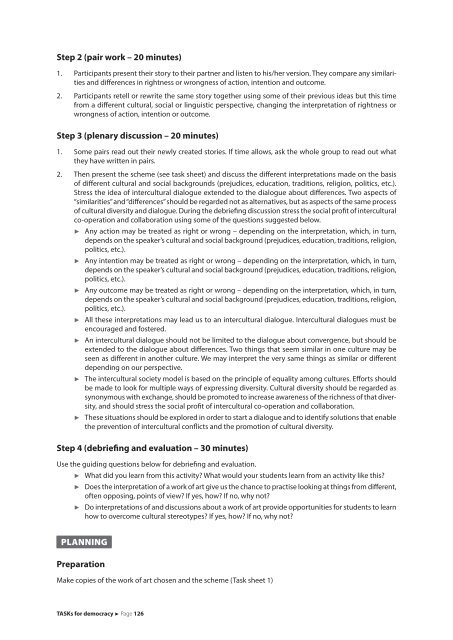TASKs for democracy
4NYw4W
4NYw4W
Create successful ePaper yourself
Turn your PDF publications into a flip-book with our unique Google optimized e-Paper software.
Step 2 (pair work – 20 minutes)<br />
1. Participants present their story to their partner and listen to his/her version. They compare any similarities<br />
and differences in rightness or wrongness of action, intention and outcome.<br />
2. Participants retell or rewrite the same story together using some of their previous ideas but this time<br />
from a different cultural, social or linguistic perspective, changing the interpretation of rightness or<br />
wrongness of action, intention or outcome.<br />
Step 3 (plenary discussion – 20 minutes)<br />
1. Some pairs read out their newly created stories. If time allows, ask the whole group to read out what<br />
they have written in pairs.<br />
2. Then present the scheme (see task sheet) and discuss the different interpretations made on the basis<br />
of different cultural and social backgrounds (prejudices, education, traditions, religion, politics, etc.).<br />
Stress the idea of intercultural dialogue extended to the dialogue about differences. Two aspects of<br />
“similarities” and “differences” should be regarded not as alternatives, but as aspects of the same process<br />
of cultural diversity and dialogue. During the debriefing discussion stress the social profit of intercultural<br />
co-operation and collaboration using some of the questions suggested below.<br />
<br />
<br />
<br />
<br />
<br />
<br />
<br />
Any action may be treated as right or wrong – depending on the interpretation, which, in turn,<br />
depends on the speaker’s cultural and social background (prejudices, education, traditions, religion,<br />
politics, etc.).<br />
Any intention may be treated as right or wrong – depending on the interpretation, which, in turn,<br />
depends on the speaker’s cultural and social background (prejudices, education, traditions, religion,<br />
politics, etc.).<br />
Any outcome may be treated as right or wrong – depending on the interpretation, which, in turn,<br />
depends on the speaker’s cultural and social background (prejudices, education, traditions, religion,<br />
politics, etc.).<br />
All these interpretations may lead us to an intercultural dialogue. Intercultural dialogues must be<br />
encouraged and fostered.<br />
An intercultural dialogue should not be limited to the dialogue about convergence, but should be<br />
extended to the dialogue about differences. Two things that seem similar in one culture may be<br />
seen as different in another culture. We may interpret the very same things as similar or different<br />
depending on our perspective.<br />
The intercultural society model is based on the principle of equality among cultures. Ef<strong>for</strong>ts should<br />
be made to look <strong>for</strong> multiple ways of expressing diversity. Cultural diversity should be regarded as<br />
synonymous with exchange, should be promoted to increase awareness of the richness of that diversity,<br />
and should stress the social profit of intercultural co-operation and collaboration.<br />
These situations should be explored in order to start a dialogue and to identify solutions that enable<br />
the prevention of intercultural conflicts and the promotion of cultural diversity.<br />
Step 4 (debriefing and evaluation – 30 minutes)<br />
Use the guiding questions below <strong>for</strong> debriefing and evaluation.<br />
<br />
<br />
<br />
What did you learn from this activity? What would your students learn from an activity like this?<br />
Does the interpretation of a work of art give us the chance to practise looking at things from different,<br />
often opposing, points of view? If yes, how? If no, why not?<br />
Do interpretations of and discussions about a work of art provide opportunities <strong>for</strong> students to learn<br />
how to overcome cultural stereotypes? If yes, how? If no, why not?<br />
PLANNING<br />
Preparation<br />
Make copies of the work of art chosen and the scheme (Task sheet 1)<br />
<strong>TASKs</strong> <strong>for</strong> <strong>democracy</strong> Page 126


